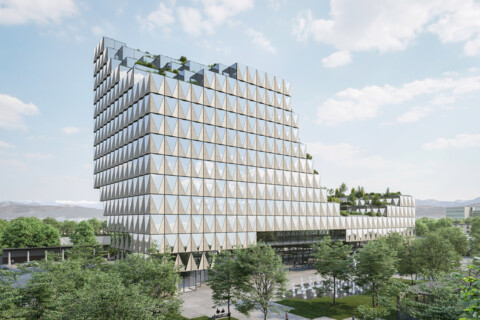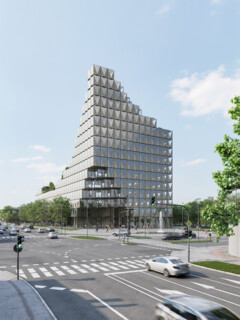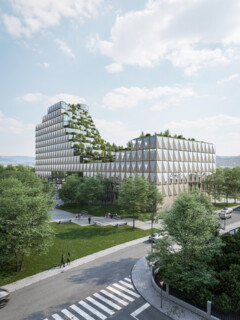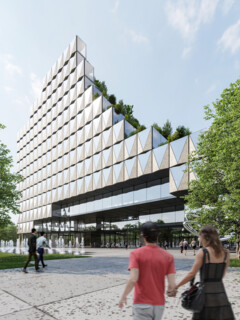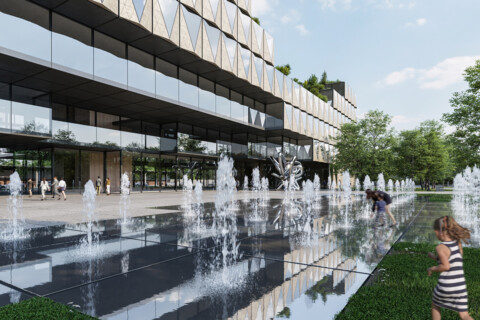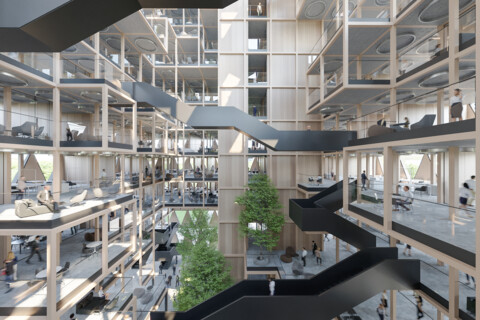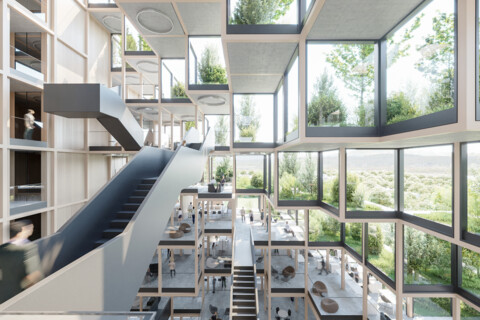- wa-ID
- wa-2030521
- Tag der Veröffentlichung
- 18.12.2020
- Aktualisiert am
- 18.12.2020
- Verfahrensart
- Einladungswettbewerb
- Teilnehmer
- Architekt*innen
- Auslober
- Petrol d.d.
- Bekanntgabe
- 17.12.2020
Verfahrensart
Einladungswettbewerb
Pressemitteilung von ENOTA, 17. Dezember 2020
ENOTA hat den ersten Preis im Rahmen des eingeladenen Architekturwettbewerbs für das neue Petrol Corporate Building gewonnen.
Das neue Gebäude ergänzt in seiner Gestaltung die Ausrichtung des Unternehmens, das sich von einem Ölhändler zu einem Anbieter von grüner Energie wandelt. Zusammen mit dem Park ist es als umfassende Gestaltung des Areals entlang des mittleren Rings von Ljubljana konzipiert und stellt einen Schlüsselpunkt entlang dieser Straße dar. An der wichtigen Kreuzung des inneren Rings wird das vertikale Element im Einklang mit dem städtebaulichen Entwurf der Stadt betont. Von diesem Punkt aus nimmt die Gebäudemasse entlang der Straße und zum Park hin allmählich ab. Die Terrasse auf dem unteren Teil des Daches und der Park verschmelzen zu einem zusammenhängenden Raum, während das begrünte Dach die Qualität der Arbeitsumgebung erhöht und die umweltfreundliche Ausrichtung des Unternehmens betont.
Der stadtbildprägende Turm an der Kreuzung und die funktional angemessenen horizontalen Lamellen werden formal in ein einheitliches Volumen mit einer schlanken und eleganten Betonung in der südlichen Ecke und einem durchgehenden, überwiegend grünen, sich zum Park hin öffnenden amphitheatralischen Dach überführt. Ausschnitte im Volumen bilden überdachte Räume (Arkadengang) zu den Straßen hin, als Gegenstück zu den Arkaden des historisch bedeutenden Stadions nach dem Entwurf von Plečnik und verdecken gleichzeitig die Eingänge zum Gebäude. Hinter dem Gebäude befindet sich ein Park, zu dem das Gebäude mit seinem großen überdachten Platz - einer Loggia - ausgerichtet ist. Gelegentlich wird dieser Platz in eine große Open-Air-Veranstaltung umgewandelt, bei der das Gebäude als Schutz vor dem Straßenverkehrslärm dient. Die Gestaltung der äußeren, gepflasterten Flächen wird durch die Gestaltung des Gebäudes und seine Modularität zusammengefasst. Ein Teil der Parkfläche ist als Bodenbrunnen gestaltet, der bei Großveranstaltungen abgeschaltet werden kann und so die nutzbare Veranstaltungsfläche vergrößert.
Das großzügige Volumen des Gebäudes ermöglicht die Realisierung von großen mehrgeschossigen Innenräumen. Sie sind ein Hybrid zwischen Außen- und Innenraum, in dem ideale klimatische Bedingungen eingehalten werden können. Zwischen diesen Räumen und der Außenfassade sind Arbeitsräume organisiert, die aus geschlossenen Bereichen bestehen, die größtenteils der Außenfassade des Gebäudes zugewandt sind, während die offenen Arbeitsräume und vor allem die Kommunikations- und Gemeinschaftsräume zum inneren Hohlraum hin orientiert sind. Dadurch werden sie natürlich belichtet, da der Zwischenraum durch die großen Nordfenster großzügig belichtet wird. Die Zwischenräume ermöglichen auch visuelle und physische Verbindungen durch viele Treppenhäuser, die entsprechende Räume in anderen Teilen des Gebäudes verbinden.
Aufgrund der räumlichen Gestaltung des Gebäudes sind alle Arbeitsflächen äußerst heterogen - von den am wenigsten belichteten Flächen in entfernten Ecken bis hin zu völlig offenen Flächen in der Mitte des Leerraums und ohne Decken. Auch mit einer Decke abgedeckte Bereiche können schallgedämmt werden, und zwar vor oder auch nach der Inbetriebnahme des Gebäudes. Alle Arbeitsräume sind komplett modular aufgebaut. In Kombination mit dem technischen Doppelboden bietet diese Modularität eine effiziente Flexibilität. So können alle Funktionsänderungen ohne nennenswerte Beeinträchtigung der Mitarbeiter oder des Gebäudebetriebs durchgeführt werden. Die Trennwände sind modular auf einem Stahlbauraster von 3,0 x 3,0 m aufgebaut und können nahezu beliebig im Gebäude verschoben werden.
Die programmatische Anordnung im Gebäude ist in der Regel völlig flexibel, aber natürlich gelten einige Regeln. Das Geschäftsprogramm befindet sich meist im südlichen, höheren Teil des Gebäudes, breitet sich aber in den unteren Etagen auf den nördlichen Teil des Gebäudes aus. Hier wird der größte Teil der Fläche als öffentliches Programm der Gemeinnützigkeit genutzt. Der südliche Teil des Parterres ist hauptsächlich für Geschäftsbesucher bestimmt. Die Trennung von geschäftlichem und öffentlichem Eingangsbereich ermöglicht einen reibungslosen Betrieb, zum Beispiel bei Veranstaltungen im öffentlichen Raum. Es ist möglich, diese Räume zu verbinden, falls sich eine solche Verbindung als bequemere Lösung für den Benutzer erweisen sollte. Die beiden typologisch unterschiedlichen Programme sind auf mehreren Ebenen miteinander verbunden, was eine interaktive und zufällige Verknüpfung unterschiedlicher Inhalte ermöglicht.
Die Kommunikationswege führen in der Regel in die Bereiche der inneren Atrien und ermöglichen eine gute visuelle Wahrnehmung des Raumes und damit eine einfache Orientierung. Diese Wege werden von offenen Arbeitsbereichen gesäumt, die entlang der Fassade zu geschlossenen Arbeitsbereichen führen. Vertikale Verbindungen mit konventionellen Aufzugsschächten und (Evakuierungs-)Treppenhäusern ermöglichen „zufällig“ angeordnete offene Treppenhäuser, die in der Regel benachbarte Etagen verbinden. Wie die anderen Kommunikationsbereiche ermöglichen sie schnelle und ungewöhnliche Verbindungen zwischen benachbarten Programmen und werden so zu Räumen für spontane Begegnungen und Interaktionen.
Press release by ENOTA, 17 December 2020
ENOTA won first prize in the invited architectural competition for the new Petrol Corporate Building.
In its design, the new building complements the orientation of a company that is transforming itself from an oil trader to a provider of green energy. Together with the park, it is designed as a comprehensive arrangement of the area along Ljubljana's middle ring and represents a key point along this road. At the important inner circle crossroads, the vertical element is emphasized in line with the urban design of the city. From this point, the building mass gradually decreases along the street and towards the park. The terrace on the lower part of the roof and the park merge into a continuous space, while the green roof increases the quality of the working environment and emphasizes the environmentally friendly orientation of the company.
The cityscape composing tower at the crossroads and the functionally appropriate horizontal lamellas are formally transformed into a uniform volume with a slender and elegant emphasis in the southern corner and continuous, predominantly green, amphitheatric roof opening towards the park. Cut-outs in the volume are forming covered spaces (arcade corridor) towards the streets, as a counterpart to the arcades on the historically important stadium designed by Plečnik and at the same time covering the entrances to the building. Behind the building there is a park to which the building faces with its large covered square - a loggia. Occasionally this square is converted into a large open-air event, where the building serves as a shelter from road traffic noise. The design of the outer paved areas is summarized by the design of the building and its modularity. Part of the park area is designed as a ground fountain that can be switched off during large events, thus increasing the usable event area.
The generous volume of the building allows the realization of large multi-storey interior spaces. They are a hybrid between exterior and interior space, in which ideal climatic conditions can be maintained. Between these spaces and the exterior façade, work spaces are organized, comprising closed areas that mostly face the building's exterior façade, while the open work spaces and, above all, the communications and common spaces are oriented towards the inner void. Thus they are naturally lit, as the void is generously illuminated from the large north windows. The voids also allow visual and physical connections through many staircases that connect corresponding rooms in other parts of the building.
Due to the spatial design of the building, all work surfaces are extremely heterogeneous - from the least exposed spaces in distant corners to completely open ones in the middle of the void and without ceilings. Areas covered with a ceiling can also be soundproofed, and this can be done before or even after the building starts operating. All workrooms are completely modular. In combination with the technical raised floor, this modularity offers efficient flexibility. As a result, all functional changes can be carried out without any significant impact on employees or building operation. The partition walls are modular to a 3,0 x 3,0 m steel construction grid and can be moved virtually anywhere across the building.
The programmatic arrangement in the building is usually completely flexible, but of course some rules apply. The business program is located mostly in the southern, higher part of the building, but spreads to the northern part of the building in the lower floors. Here, most of the space is used as a public program of public utility work. The southern part of the parterre is mainly intended for business visitors. The separation of the business and public entrance area enables smooth operation, for example during events in public spaces. It is possible to connect these spaces if such a connection should prove to be a more convenient solution for the user. The two typologically different programs are connected on several levels, which allows an interactive and random connection of different contents.
The communication paths usually lead to areas around the inner atriums and allow for a good visual perception of the space and thus easy orientation. These paths are lined with open workspaces, which lead to closed workspaces along the façade. Vertical connections with conventional elevator shafts and (evacuation) staircases allow randomly arranged open staircases that usually connect adjacent floors. Like the other communication areas, they allow fast and unusual connections between adjacent programs and thus become spaces for spontaneous encounters and interactions.
Einladungswettbewerb
Pressemitteilung von ENOTA, 17. Dezember 2020
ENOTA hat den ersten Preis im Rahmen des eingeladenen Architekturwettbewerbs für das neue Petrol Corporate Building gewonnen.
Das neue Gebäude ergänzt in seiner Gestaltung die Ausrichtung des Unternehmens, das sich von einem Ölhändler zu einem Anbieter von grüner Energie wandelt. Zusammen mit dem Park ist es als umfassende Gestaltung des Areals entlang des mittleren Rings von Ljubljana konzipiert und stellt einen Schlüsselpunkt entlang dieser Straße dar. An der wichtigen Kreuzung des inneren Rings wird das vertikale Element im Einklang mit dem städtebaulichen Entwurf der Stadt betont. Von diesem Punkt aus nimmt die Gebäudemasse entlang der Straße und zum Park hin allmählich ab. Die Terrasse auf dem unteren Teil des Daches und der Park verschmelzen zu einem zusammenhängenden Raum, während das begrünte Dach die Qualität der Arbeitsumgebung erhöht und die umweltfreundliche Ausrichtung des Unternehmens betont.
Der stadtbildprägende Turm an der Kreuzung und die funktional angemessenen horizontalen Lamellen werden formal in ein einheitliches Volumen mit einer schlanken und eleganten Betonung in der südlichen Ecke und einem durchgehenden, überwiegend grünen, sich zum Park hin öffnenden amphitheatralischen Dach überführt. Ausschnitte im Volumen bilden überdachte Räume (Arkadengang) zu den Straßen hin, als Gegenstück zu den Arkaden des historisch bedeutenden Stadions nach dem Entwurf von Plečnik und verdecken gleichzeitig die Eingänge zum Gebäude. Hinter dem Gebäude befindet sich ein Park, zu dem das Gebäude mit seinem großen überdachten Platz - einer Loggia - ausgerichtet ist. Gelegentlich wird dieser Platz in eine große Open-Air-Veranstaltung umgewandelt, bei der das Gebäude als Schutz vor dem Straßenverkehrslärm dient. Die Gestaltung der äußeren, gepflasterten Flächen wird durch die Gestaltung des Gebäudes und seine Modularität zusammengefasst. Ein Teil der Parkfläche ist als Bodenbrunnen gestaltet, der bei Großveranstaltungen abgeschaltet werden kann und so die nutzbare Veranstaltungsfläche vergrößert.
Das großzügige Volumen des Gebäudes ermöglicht die Realisierung von großen mehrgeschossigen Innenräumen. Sie sind ein Hybrid zwischen Außen- und Innenraum, in dem ideale klimatische Bedingungen eingehalten werden können. Zwischen diesen Räumen und der Außenfassade sind Arbeitsräume organisiert, die aus geschlossenen Bereichen bestehen, die größtenteils der Außenfassade des Gebäudes zugewandt sind, während die offenen Arbeitsräume und vor allem die Kommunikations- und Gemeinschaftsräume zum inneren Hohlraum hin orientiert sind. Dadurch werden sie natürlich belichtet, da der Zwischenraum durch die großen Nordfenster großzügig belichtet wird. Die Zwischenräume ermöglichen auch visuelle und physische Verbindungen durch viele Treppenhäuser, die entsprechende Räume in anderen Teilen des Gebäudes verbinden.
Aufgrund der räumlichen Gestaltung des Gebäudes sind alle Arbeitsflächen äußerst heterogen - von den am wenigsten belichteten Flächen in entfernten Ecken bis hin zu völlig offenen Flächen in der Mitte des Leerraums und ohne Decken. Auch mit einer Decke abgedeckte Bereiche können schallgedämmt werden, und zwar vor oder auch nach der Inbetriebnahme des Gebäudes. Alle Arbeitsräume sind komplett modular aufgebaut. In Kombination mit dem technischen Doppelboden bietet diese Modularität eine effiziente Flexibilität. So können alle Funktionsänderungen ohne nennenswerte Beeinträchtigung der Mitarbeiter oder des Gebäudebetriebs durchgeführt werden. Die Trennwände sind modular auf einem Stahlbauraster von 3,0 x 3,0 m aufgebaut und können nahezu beliebig im Gebäude verschoben werden.
Die programmatische Anordnung im Gebäude ist in der Regel völlig flexibel, aber natürlich gelten einige Regeln. Das Geschäftsprogramm befindet sich meist im südlichen, höheren Teil des Gebäudes, breitet sich aber in den unteren Etagen auf den nördlichen Teil des Gebäudes aus. Hier wird der größte Teil der Fläche als öffentliches Programm der Gemeinnützigkeit genutzt. Der südliche Teil des Parterres ist hauptsächlich für Geschäftsbesucher bestimmt. Die Trennung von geschäftlichem und öffentlichem Eingangsbereich ermöglicht einen reibungslosen Betrieb, zum Beispiel bei Veranstaltungen im öffentlichen Raum. Es ist möglich, diese Räume zu verbinden, falls sich eine solche Verbindung als bequemere Lösung für den Benutzer erweisen sollte. Die beiden typologisch unterschiedlichen Programme sind auf mehreren Ebenen miteinander verbunden, was eine interaktive und zufällige Verknüpfung unterschiedlicher Inhalte ermöglicht.
Die Kommunikationswege führen in der Regel in die Bereiche der inneren Atrien und ermöglichen eine gute visuelle Wahrnehmung des Raumes und damit eine einfache Orientierung. Diese Wege werden von offenen Arbeitsbereichen gesäumt, die entlang der Fassade zu geschlossenen Arbeitsbereichen führen. Vertikale Verbindungen mit konventionellen Aufzugsschächten und (Evakuierungs-)Treppenhäusern ermöglichen „zufällig“ angeordnete offene Treppenhäuser, die in der Regel benachbarte Etagen verbinden. Wie die anderen Kommunikationsbereiche ermöglichen sie schnelle und ungewöhnliche Verbindungen zwischen benachbarten Programmen und werden so zu Räumen für spontane Begegnungen und Interaktionen.
Press release by ENOTA, 17 December 2020
ENOTA won first prize in the invited architectural competition for the new Petrol Corporate Building.
In its design, the new building complements the orientation of a company that is transforming itself from an oil trader to a provider of green energy. Together with the park, it is designed as a comprehensive arrangement of the area along Ljubljana's middle ring and represents a key point along this road. At the important inner circle crossroads, the vertical element is emphasized in line with the urban design of the city. From this point, the building mass gradually decreases along the street and towards the park. The terrace on the lower part of the roof and the park merge into a continuous space, while the green roof increases the quality of the working environment and emphasizes the environmentally friendly orientation of the company.
The cityscape composing tower at the crossroads and the functionally appropriate horizontal lamellas are formally transformed into a uniform volume with a slender and elegant emphasis in the southern corner and continuous, predominantly green, amphitheatric roof opening towards the park. Cut-outs in the volume are forming covered spaces (arcade corridor) towards the streets, as a counterpart to the arcades on the historically important stadium designed by Plečnik and at the same time covering the entrances to the building. Behind the building there is a park to which the building faces with its large covered square - a loggia. Occasionally this square is converted into a large open-air event, where the building serves as a shelter from road traffic noise. The design of the outer paved areas is summarized by the design of the building and its modularity. Part of the park area is designed as a ground fountain that can be switched off during large events, thus increasing the usable event area.
The generous volume of the building allows the realization of large multi-storey interior spaces. They are a hybrid between exterior and interior space, in which ideal climatic conditions can be maintained. Between these spaces and the exterior façade, work spaces are organized, comprising closed areas that mostly face the building's exterior façade, while the open work spaces and, above all, the communications and common spaces are oriented towards the inner void. Thus they are naturally lit, as the void is generously illuminated from the large north windows. The voids also allow visual and physical connections through many staircases that connect corresponding rooms in other parts of the building.
Due to the spatial design of the building, all work surfaces are extremely heterogeneous - from the least exposed spaces in distant corners to completely open ones in the middle of the void and without ceilings. Areas covered with a ceiling can also be soundproofed, and this can be done before or even after the building starts operating. All workrooms are completely modular. In combination with the technical raised floor, this modularity offers efficient flexibility. As a result, all functional changes can be carried out without any significant impact on employees or building operation. The partition walls are modular to a 3,0 x 3,0 m steel construction grid and can be moved virtually anywhere across the building.
The programmatic arrangement in the building is usually completely flexible, but of course some rules apply. The business program is located mostly in the southern, higher part of the building, but spreads to the northern part of the building in the lower floors. Here, most of the space is used as a public program of public utility work. The southern part of the parterre is mainly intended for business visitors. The separation of the business and public entrance area enables smooth operation, for example during events in public spaces. It is possible to connect these spaces if such a connection should prove to be a more convenient solution for the user. The two typologically different programs are connected on several levels, which allows an interactive and random connection of different contents.
The communication paths usually lead to areas around the inner atriums and allow for a good visual perception of the space and thus easy orientation. These paths are lined with open workspaces, which lead to closed workspaces along the façade. Vertical connections with conventional elevator shafts and (evacuation) staircases allow randomly arranged open staircases that usually connect adjacent floors. Like the other communication areas, they allow fast and unusual connections between adjacent programs and thus become spaces for spontaneous encounters and interactions.
